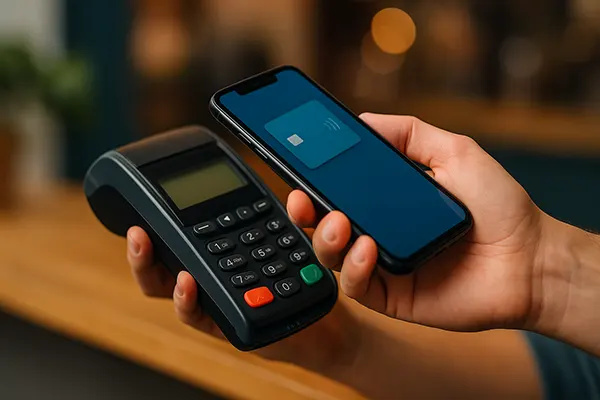Over the last decade, contactless payments have moved from being a novelty to an everyday reality. Today, smartphones equipped with NFC (Near Field Communication) technology allow people to pay in shops, restaurants, and even on public transport without carrying a physical bank card. But the question that still concerns many users in 2025 is how safe mobile NFC payments really are. Let us explore the mechanisms behind them, their security, and the possible risks you should be aware of.
How NFC Payments Work
NFC technology enables a short-range wireless connection between two devices, typically no more than four centimetres apart. When you bring your smartphone close to a payment terminal, the built-in NFC chip exchanges encrypted information with the terminal. This process allows the transaction to be authorised securely without exposing your full card details. Instead of transmitting sensitive data directly, the system uses a unique token generated for that specific transaction.
This tokenisation approach ensures that even if someone intercepted the signal, the information would be useless for creating fraudulent payments. Banks and payment services like Apple Pay, Google Pay, and Samsung Pay have made tokenisation the cornerstone of their mobile payment systems. This design minimises exposure and reduces the risk compared to traditional magnetic stripe cards.
Additionally, NFC transactions rely on two-step verification: the smartphone itself and user authentication. Most modern smartphones require biometric confirmation, such as a fingerprint or facial recognition, before the payment is approved. This adds an extra layer of security, making it harder for criminals to exploit lost or stolen devices.
Security Layers in NFC Payments
One of the main strengths of NFC payments is the multiple layers of protection. Firstly, the hardware-based security modules built into devices are specifically designed to store sensitive payment data. Secondly, banks and payment providers use sophisticated fraud-detection algorithms that track transaction patterns in real time and flag suspicious activity immediately.
Another essential safeguard is the dynamic nature of the transaction codes. Each payment is authorised with a one-time code that cannot be reused, which means that cloning NFC payment data is practically impossible. In contrast, magnetic stripe cards can be duplicated with relative ease, which is why they have become outdated in many countries.
Finally, smartphone operating systems regularly release security updates to close vulnerabilities and strengthen device protection. By keeping your phone updated, you reduce the risk of exploitation through malware or unauthorised apps. This illustrates why the safety of NFC payments depends not only on the bank or service provider but also on the user’s device management.
Risks and Misconceptions
Despite its strengths, NFC technology is not entirely free from risks. One of the most common concerns is the fear of “skimming,” where criminals could theoretically intercept NFC signals. In reality, this risk is extremely low because of the limited range of NFC and the encryption methods used. Attempting to capture data from a distance is both technically challenging and unlikely to produce useful information.
Another concern arises when devices are lost or stolen. While biometric authentication and PIN protection significantly reduce the risk, careless storage of banking information or weak security settings can expose users to fraud. Therefore, enabling features such as remote device locking and data wiping is essential in safeguarding mobile wallets.
A further misconception is that mobile payments are more vulnerable than physical cards. Studies and reports from financial regulators across Europe and North America have consistently shown the opposite: NFC smartphone transactions are statistically safer due to the encryption and tokenisation involved. The main risks usually stem from users not following basic digital hygiene practices rather than flaws in the technology itself.
Practical Tips for Users
To maximise security, users should ensure that biometric authentication is always enabled for payments. This prevents unauthorised individuals from making purchases if the device falls into the wrong hands. PIN codes or passwords should also be strong and unique to prevent easy guessing.
Installing apps only from trusted sources is another critical rule. Fake or malicious apps can compromise device security, and by extension, payment information. Keeping the operating system up to date ensures the latest patches against newly discovered threats are in place.
Finally, monitoring account activity regularly helps detect unusual transactions quickly. Banks now provide instant push notifications for every payment, allowing users to respond immediately in case of suspicious charges. Combining these practices with the inherent security of NFC technology creates a strong defence against financial fraud.

The Future of NFC Payments
Looking ahead, mobile NFC payments are set to expand even further. By 2025, many governments and transport systems have already integrated NFC solutions for tickets and identity verification, signalling a broader adoption beyond shopping. Financial institutions are also working on embedding additional biometric security layers, such as palm or vein recognition, into mobile wallets.
Another development is the growing use of artificial intelligence in fraud detection. AI-driven systems analyse spending behaviour across millions of users to identify anomalies that could indicate fraud. This proactive approach means that suspicious transactions are often blocked in real time, preventing losses before they occur.
Moreover, partnerships between banks, smartphone manufacturers, and regulators are shaping global standards for mobile payments. These standards are designed to ensure that regardless of country or service provider, users enjoy the same level of safety and convenience. This harmonisation reduces fragmentation and increases consumer trust in mobile transactions.
Long-Term Outlook
The long-term outlook for NFC payments suggests that they will eventually replace many traditional card transactions entirely. As more shops, public services, and online systems embrace this technology, carrying a physical wallet may become unnecessary for most people. The convenience of having everything on a smartphone aligns with broader trends in digitalisation.
Nevertheless, education remains critical. Users must understand both the strengths and limitations of NFC payments. A secure system can still be undermined by poor user practices, such as storing login details in unsafe places or ignoring suspicious activity alerts. Raising awareness is therefore a key priority for financial institutions and technology companies alike.
In conclusion, mobile NFC payments represent a secure, efficient, and forward-looking alternative to traditional cards. When combined with proper user responsibility, they are one of the safest ways to conduct everyday transactions in 2025 and beyond.




